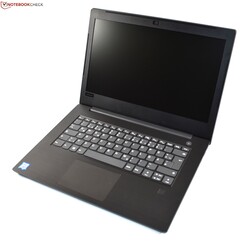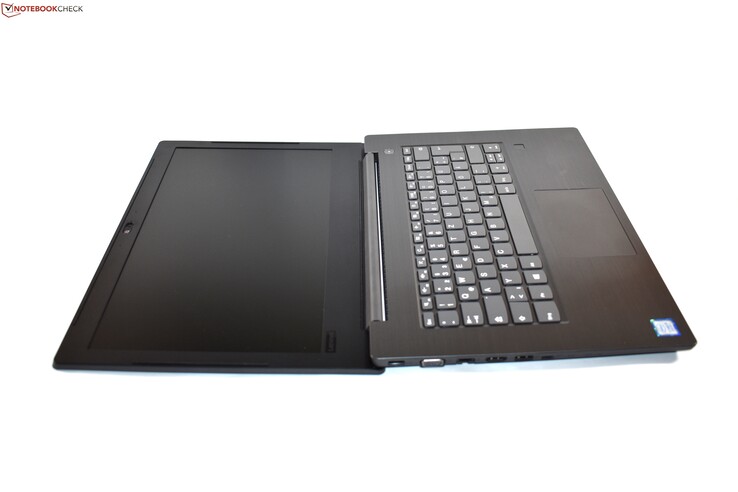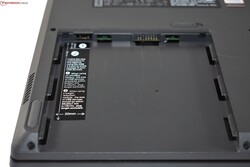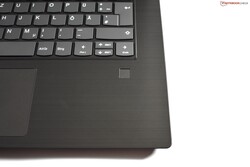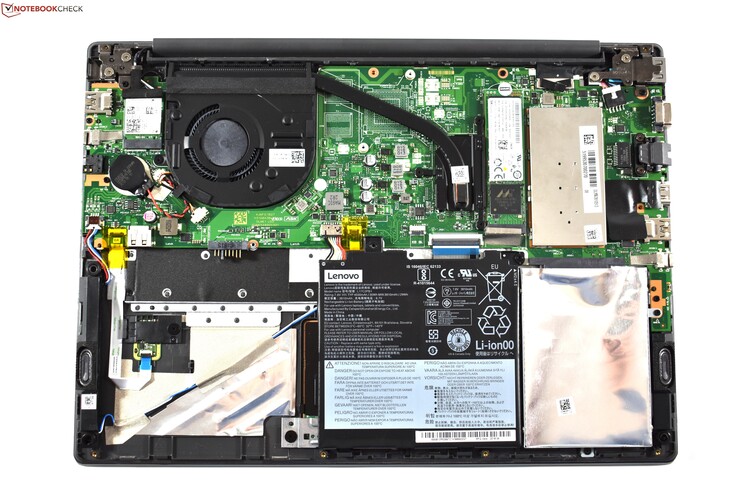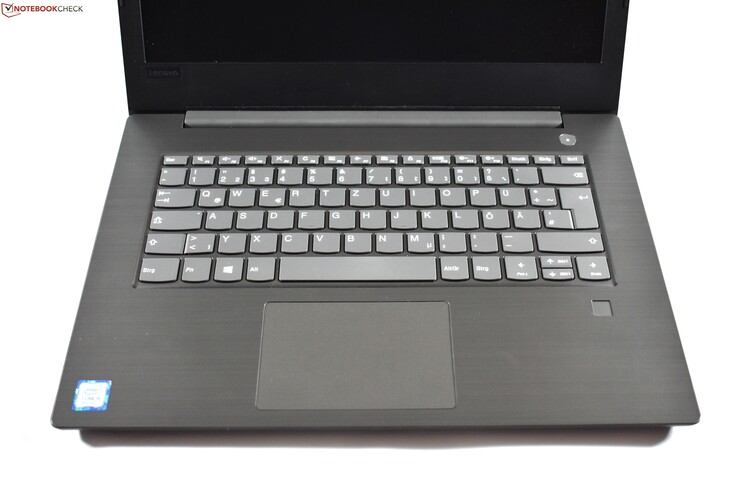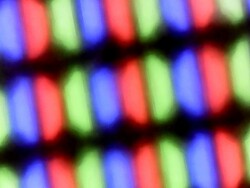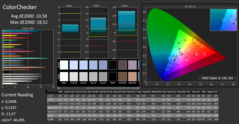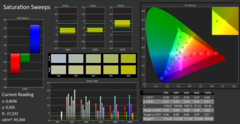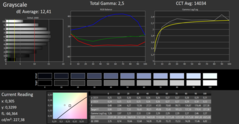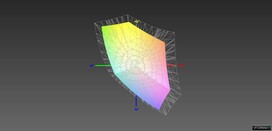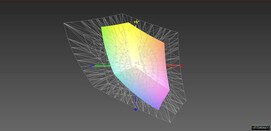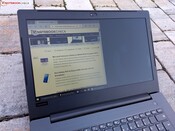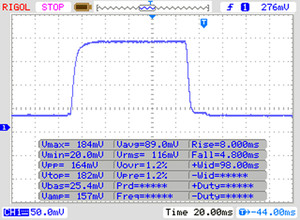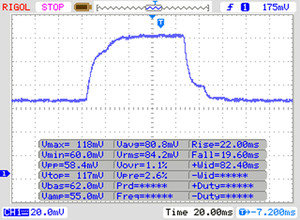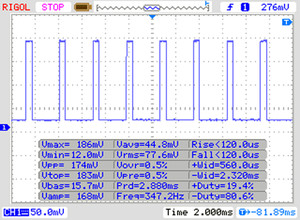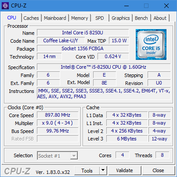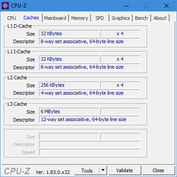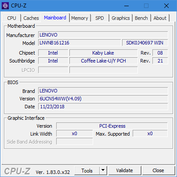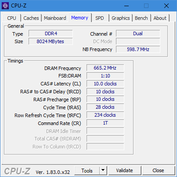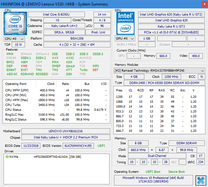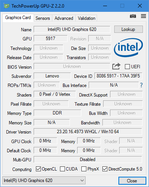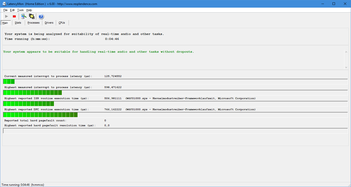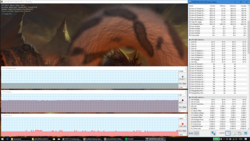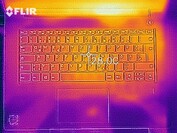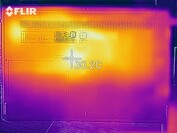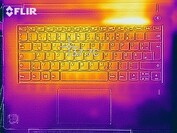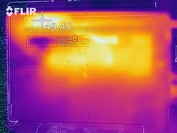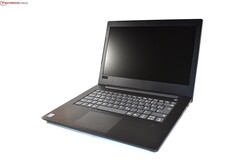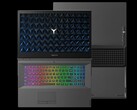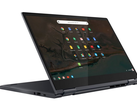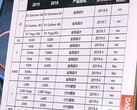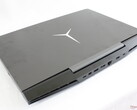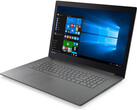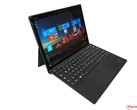Lenovo V330-14IKB (i5, FHD) Laptop Review

Business laptops made by Lenovo – one could be forgiven to think that those are always called ThinkPad. But this is not true; Lenovo has been making non-ThinkPad laptops for businesses for a long time. Originally, those laptops were called "Lenovo 3000", but now they are simply called "Lenovo V series". Those V series laptops are neither part of the professional ThinkPad lineup nor are they part of the consumer-brand IdeaPad. Today's review unit has the model number Lenovo V330-14IKB, and it is one of the newest models of the Lenovo V series.
The model number of the Lenovo laptops tells us a few things about its positioning: As a model of the V300 series, this is an affordable laptop. The second "3" of the model name shows that this is the third model of this series. The "14" tells us that this is a laptop with a 14-inch screen. All of this puts the V330-14IKB in a highly contested part of the market, which nearly all well-known manufacturers are competing for. As its main competitors, we see the HP 14, the HP ProBook 440 G5, the Dell Latitude 3490 and the Lenovo ThinkPad E480 as an important competitor from Lenovo itself.
The tested model of the Lenovo V330-14IKB carries the model-number 81B0004MGE. It includes an Intel Core i5 CPU, 8 GB RAM, a 256 GB SSD and an FHD (1920x1080) screen. This package is available for an affordable 580 Euros (~$657) from some German resellers, although the list-price is slightly higher (650 Euros, ~$737).
Case
While Lenovo ThinkPads are almost always completely black, Lenovo uses a dark gray color for the V330-14IKB. The laptop still has a subdued and simple design, though maybe not as conservative as the ThinkPads. The palm rest and screen cover have a metallic feel, which also is not the case with ThinkPads. We cannot say for sure if this is aluminum or stylized plastic, though we would guess it is the latter material. In Lenovo's data sheet, the material is simply listed as plastic, but it is not specified which parts exactly are made out of plastic. In any case, the bottom cover and screen bezel are made out of rough plastic.
Certainly, the build quality of the Lenovo laptop V330-14IKB cannot compete with the more-expensive ThinkPads. For example, the workmanship in the area of the screen cover is not completely perfect; the grout between the chassis parts here is clearly palpable. Also, the lid rocks back and forth a little bit because of the hinges, which are slightly too loose. Pressure on the back of the screen cover is quickly passed on to the panel, and the base unit as well as the lid are pretty flexible. At least the palmrest itself does not flex much.
It is not possible to open the screen with one hand as the hinges are too tight on the first opening-angle centimeters for that. A small consolation is the fact that the screen can be opened to 180 degrees, enabling a more flexible user experience.
With a measured weight of roughly 1.7 kg, the Lenovo V330-14IKB is not what you would call "extremely light-weight", though the Lenovo ThinkPad E480 is still heavier at 1.8 kg. The competitors of the other manufacturers are either as heavy or lighter. There are some bigger differences when it comes to the footprint, as the Lenovo V330-14IKB is the biggest of the compared 14-inch laptops. That is the reason why the display bezels around the screen are pretty wide, making the design look outdated.
Connectivity
The roomy chassis of the Lenovo V330-14IKB offers enough room for ports. With VGA, RJ45-Ethernet, HDMI and a full-size SD card-slot, it has more ports than some much more-expensive business laptops. Especially the analog VGA port has become rare. Luckily, the V330-14IKB not only offers legacy standards but also offers two USB Type-C ports on both sides of the case. They do not offer Thunderbolt 3, but this standard is still rarely seen on devices of this price class anyway. The USB Type-C port on the left side can transfer data, act as a DisplayPort, and it can also be used to charge the device with Power Delivery – this port is ideal for a USB Type-C dock. Too bad that it is positioned so far to the front, which makes using this port more cumbersome than it should be, especially for charging. The USB port on the right side can only be used for USB devices.
The Lenovo V330-14IKB has a special feature that nearly no other recently released laptop features: A modular UltraBay. This is important when it comes to the ports, because there is another USB A port inside the UltraBay. This means that it is possible to hide a USB device inside the UltraBay, for example a USB stick to expand the storage. It is important to note though that the device cannot be bigger than 8 x 20 x 7 mm (W x L x H), as the UltraBay module only offers a finite amount of room. Also, the speed of this USB port is limited to USB 2.0.
SD card-reader
The SD card-reader on the right side of the chassis can take in normal SD cards, which means that the V330-14IKB offers a greater flexibility than the Lenovo ThinkPad E480 with its microSD card-reader. Most other competitors also sport a full-size SD card-slot.
Unfortunately, the SD card-reader is extremely slow, as our benchmarks with the Toshiba Exceria Pro SDXC 64 GB UHS-II reference card show. The HP 14 and the Dell Latitude 3490 have SD card-readers that are as fast, only the HP ProBook 440 G5 has a much faster full-size SD card-slot.
| SD Card Reader | |
| average JPG Copy Test (av. of 3 runs) | |
| HP ProBook 440 G5-3KX87ES (Toshiba Exceria Pro SDXC 64 GB UHS-II) | |
| Lenovo ThinkPad E480-20KQS00000 (Toshiba Exceria Pro M501) | |
| Average of class Office (22.4 - 198.5, n=28, last 2 years) | |
| Dell Latitude 3490 (Toshiba Exceria Pro SDXC 64 GB UHS-II) | |
| HP 14-ma0312ng (Toshiba Exceria Pro SDXC 64 GB UHS-II) | |
| Lenovo V330-14IKB-81B0004MGE (Toshiba Exceria Pro SDXC 64 GB UHS-II) | |
| maximum AS SSD Seq Read Test (1GB) | |
| HP ProBook 440 G5-3KX87ES (Toshiba Exceria Pro SDXC 64 GB UHS-II) | |
| Lenovo ThinkPad E480-20KQS00000 (Toshiba Exceria Pro M501) | |
| Average of class Office (25 - 249, n=26, last 2 years) | |
| Lenovo V330-14IKB-81B0004MGE (Toshiba Exceria Pro SDXC 64 GB UHS-II) | |
| HP 14-ma0312ng (Toshiba Exceria Pro SDXC 64 GB UHS-II) | |
| Dell Latitude 3490 (Toshiba Exceria Pro SDXC 64 GB UHS-II) | |
Communication
More-expensive business laptops often sport 2x2 solutions by Intel like the Dual Band Wireless 8265. The V330-14IKB meanwhile is limited to the 1x1 Wi-Fi solution Intel 3165. This Wi-Fi card delivered a stable performance in everyday use and the benchmarks, but its maximum speed is limited. Only the HP 14 is worse in this regard. Optionally, the Lenovo laptop V330-14IKB should be available with a 2x2 solution as well, but all models for the European market are equipped with the 1x1 WLAN card. Apart from Wi-Fi, the V330-14IKB also has Bluetooth 4.1 as well as an RJ45-Ethernet port. WWAN is no option, but that is absolutely normal in this price class.
The webcam is an extremely cheap model and takes very grainy and washed-out pictures. Its quality is barely enough for video-conferencing. The two microphones that sit next to the webcam in the display bezel are at least slightly better.
Security
For an affordable laptop, the Lenovo V330-14IKB has a good amount of security features. On the right side of the chassis, there is a Kensington lock slot, which can be useful to stop someone from stealing the laptop. In the palm rest area, Lenovo places a touch-based fingerprint sensor, which worked well during our test with Windows Hello. While a fingerprint sensor is nothing special anymore, mechanical camera shutters are still pretty rare. The expensive HP EliteBooks and Lenovo ThinkPads have had such camera shutters since 2018 and the Lenovo V330-14IKB sports one as well – while the slightly more-expensive Lenovo ThinkPad E480 does not have this feature.
Accessories
Apart from the 45 W charger, the Lenovo V330-14IKB comes standard with a dummy for the modular UltraBay. This dummy is called "weight saving module" and offers room for a USB device, which can be connected to the USB port in the UltraBay. Otherwise, it has no function.
Optionally, there is another use for the modular bay: an UltraBay battery. With it, the battery capacity can be increased by 39 Wh. This battery with the part-number GX50Q95754 should cost roughly 50 Euros (~$56), although availability of this accessory seems to be rather difficult right now.
Maintenance
To get to the innards of the Lenovo notebook, 10 screws have to be removed. The second step is to loosen the plastic clips that still hold the bottom cover in place. This step should be done with a plastic spudger or a similar tool, and it should be done carefully without much force. When the bottom cover is removed, all components sans keyboard, touchpad and display are accessible. For example, it is possible to clean the fan or to apply new thermal paste. Also, the M.2 SSD and the single RAM module are upgradeable and the small battery is accessible as well. To the right of the battery, there is a 2.5 inch storage bay. This slot is empty on our review unit, but since the caddy is here, it should be possible to easily upgrade the Lenovo V330-14IKB with an M.2 SSD. All in all, this laptop is pretty upgradeable.
Warranty
As is the norm with more-affordable business laptops, the Lenovo V330-14IKB only has one year of bring-in warranty. Users have the option to prolong the warranty to a maximum of three years. It is possible to purchase additional services like the Accidental Damage Protection (ADP) and on-site service as well. It is possible to almost match the ThinkPads in terms of the warranty quality, although ThinkPads often have five years as their maximum possible amount of warranty. Please see our Guarantees, Return policies and Warranties article for country-specific information.
Input devices
Keyboard
Lenovo uses a keyboard with six vertical rows of chiclet keys. Typical for Lenovo, these keys are rounded at the bottom, although this is less pronounced than on the ThinkPads. The keyboard used here does not rival the ThinkPad keyboards in quality. The keys offer enough travel and the structural support of the chassis is strong enough to prevent flex, but the pressure point is definitely less defined than on a ThinkPad. Typing longer texts with this keyboard is definitely possible, but a user can easily notice that this is a cheaper device.
There is no backlit keyboard, not even optionally – Lenovo omits this option for the V330-14IKB completely.
Touchpad
Beneath the keyboard and in the middle of the palm rest, Lenovo places the touchpad of the V330-14IKB. Its touch-sensitive surface is made out of plastic and measures 10.5 x 7 cm. The touchpad is of reasonably good quality, and it enables a pretty precise control of the mouse pointer. Gestures with multiple fingers are also possible, though this does not work as well as we hoped. Zooming in with two fingers for example is very jittery. The touchpad is not a Microsoft Precision Touchpad.
There is no TrackPoint option for this affordable business device. For this feature, users have to choose a ThinkPad as far as Lenovo is concerned.
Display
Lenovo has listed two display options for the V330-14IKB in its data sheet: An HD screen (1366x768) and an FHD screen (1920x1080). It is positive that both screens have a matte surface. On the other hand, it is very negative that Lenovo exclusively uses panels based on the Twisted Nematic (TN) technology. This outdated LCD technology is cheaper than In Plane Switching (IPS), but it also exhibits many disadvantages in comparison to IPS.
The screen brightness depends more on the LED backlight than on the LCD technology. According to Lenovo, the BOE FHD screen used here should reach a brightness value of 220 cd/m². According to our measurements, the average brightness amounts to 216 cd/m², coming close to the promised 220 cd/m². Of course, 220 cd/m² is not that much to begin with and the panel is pretty dark. In this regard, the screens of the Lenovo ThinkPad E480 and the Dell Latitude 3490 are better, though their overall brightness of 230 to 240 cd/m² is not particularly high either.
Backlight bleeding is generally not a huge problem with TN panels. The brightness distribution of 79% could be better, though the brightness looks uniform enough to the naked eye. It is too bad that the screen is plagued by PWM with a low frequency of 350 Hz when used with less than 90% of its screen brightness. Such a low PWM frequency can induce headaches for sensible users.
| |||||||||||||||||||||||||
Brightness Distribution: 79 %
Center on Battery: 225 cd/m²
Contrast: 433:1 (Black: 0.52 cd/m²)
ΔE ColorChecker Calman: 10.58 | ∀{0.5-29.43 Ø4.77}
ΔE Greyscale Calman: 12.41 | ∀{0.09-98 Ø5}
68% sRGB (Argyll 1.6.3 3D)
43% AdobeRGB 1998 (Argyll 1.6.3 3D)
42.98% AdobeRGB 1998 (Argyll 3D)
61.4% sRGB (Argyll 3D)
41.47% Display P3 (Argyll 3D)
Gamma: 2.5
CCT: 14034 K
| Lenovo V330-14IKB-81B0004MGE NT140FHM-N41, , 1920x1080, 14" | HP 14-ma0312ng AU Optronics B140XTN07.2, , 1366x768, 14" | Dell Latitude 3490 LP140WF6 / LGD059D, , 1920x1080, 14" | HP ProBook 440 G5-3KX87ES LGD04B2, , 1920x1080, 14" | Lenovo ThinkPad E480-20KQS00000 Innolux N140HCA-EAC, , 1920x1080, 14" | |
|---|---|---|---|---|---|
| Display | -5% | -4% | -4% | 1% | |
| Display P3 Coverage (%) | 41.47 | 39.31 -5% | 39.81 -4% | 39.56 -5% | 41.88 1% |
| sRGB Coverage (%) | 61.4 | 59.2 -4% | 59.6 -3% | 59.3 -3% | 62.8 2% |
| AdobeRGB 1998 Coverage (%) | 42.98 | 40.61 -6% | 41.16 -4% | 40.88 -5% | 43.29 1% |
| Response Times | -16% | -45% | -69% | -84% | |
| Response Time Grey 50% / Grey 80% * (ms) | 41 ? | 40 ? 2% | 36.4 ? 11% | 40 ? 2% | 44 ? -7% |
| Response Time Black / White * (ms) | 12 ? | 16 ? -33% | 24 ? -100% | 28.8 ? -140% | 31.2 ? -160% |
| PWM Frequency (Hz) | 350 ? | 24880 ? | |||
| Screen | -8% | 28% | 25% | 43% | |
| Brightness middle (cd/m²) | 225 | 240 7% | 250 11% | 236 5% | 251 12% |
| Brightness (cd/m²) | 216 | 216 0% | 241 12% | 221 2% | 231 7% |
| Brightness Distribution (%) | 79 | 84 6% | 81 3% | 88 11% | 80 1% |
| Black Level * (cd/m²) | 0.52 | 0.56 -8% | 0.25 52% | 0.26 50% | 0.19 63% |
| Contrast (:1) | 433 | 429 -1% | 1000 131% | 908 110% | 1321 205% |
| Colorchecker dE 2000 * | 10.58 | 13.14 -24% | 5.5 48% | 5.7 46% | 5.1 52% |
| Colorchecker dE 2000 max. * | 18.52 | 21.06 -14% | 23.5 -27% | 22 -19% | 10.6 43% |
| Greyscale dE 2000 * | 12.41 | 14.89 -20% | 3.5 72% | 3.8 69% | 4.5 64% |
| Gamma | 2.5 88% | 2.62 84% | 2.27 97% | 2.1 105% | 2.18 101% |
| CCT | 14034 46% | 19625 33% | 7049 92% | 7318 89% | 6146 106% |
| Color Space (Percent of AdobeRGB 1998) (%) | 43 | 38 -12% | 37.9 -12% | 37.7 -12% | 39.8 -7% |
| Color Space (Percent of sRGB) (%) | 68 | 59 -13% | 59.4 -13% | 59.2 -13% | 62.5 -8% |
| Colorchecker dE 2000 calibrated * | 12.71 | 4.8 | |||
| Total Average (Program / Settings) | -10% /
-8% | -7% /
12% | -16% /
7% | -13% /
18% |
* ... smaller is better
Subjectively, the image quality of the screen is really bad. This comes as no surprise, the low contrast-value of 433:1 means that the images all look washed-out. The contrast results from the high black value of 0.52 cd/m², which is why black looks rather like a dark gray. The sharpness of the picture is alright (PPI 157). The colors meanwhile have an extremely blue tint ex-factory. This can be reduced by calibrating the screen.
The color gamut coverage of the screen does not have to be discussed in lengthy sentences. Simply put, it is lousy. Serious photo-editing with this screen is generally not possible.
Display Response Times
| ↔ Response Time Black to White | ||
|---|---|---|
| 12 ms ... rise ↗ and fall ↘ combined | ↗ 8 ms rise | |
| ↘ 4 ms fall | ||
| The screen shows good response rates in our tests, but may be too slow for competitive gamers. In comparison, all tested devices range from 0.1 (minimum) to 240 (maximum) ms. » 30 % of all devices are better. This means that the measured response time is better than the average of all tested devices (20.2 ms). | ||
| ↔ Response Time 50% Grey to 80% Grey | ||
| 41 ms ... rise ↗ and fall ↘ combined | ↗ 22 ms rise | |
| ↘ 19 ms fall | ||
| The screen shows slow response rates in our tests and will be unsatisfactory for gamers. In comparison, all tested devices range from 0.165 (minimum) to 636 (maximum) ms. » 64 % of all devices are better. This means that the measured response time is worse than the average of all tested devices (31.6 ms). | ||
Screen Flickering / PWM (Pulse-Width Modulation)
| Screen flickering / PWM detected | 350 Hz | ≤ 90 % brightness setting | |
The display backlight flickers at 350 Hz (worst case, e.g., utilizing PWM) Flickering detected at a brightness setting of 90 % and below. There should be no flickering or PWM above this brightness setting. The frequency of 350 Hz is relatively high, so most users sensitive to PWM should not notice any flickering. However, there are reports that some users are still sensitive to PWM at 500 Hz and above, so be aware. In comparison: 53 % of all tested devices do not use PWM to dim the display. If PWM was detected, an average of 8084 (minimum: 5 - maximum: 343500) Hz was measured. | |||
The viewing-angle stability is bad and is typical for a TN screen. Even very small deviations from the optimal position let the picture become washed-out or invert the colors, especially when it comes to the vertical viewing angles. Even for simple office tasks, the bad viewing-angle stability is very distracting and annoying.
Performance
In Germany, the resellers just list two different models of the Lenovo V330-14IKB. Both include a 256 GB SSD, 8 GB DDR4-2400 RAM (4 GB soldered down, maximum 36 GB) and the FHD TN display. The only relevant difference between both configurations is the CPU: Our cheaper unit has the Intel Core i5-8250U, while the more-expensive model of the Lenovo V330-14IKB includes the Core i7-8550U.
Processor
The Intel Core i5-8250U is a quad-core processor of the Kaby Lake Refresh generation, which is marketed by Intel as the eighth generation of Core i processors. The four cores of this often-used CPU have a clock rate of 1.6 to 3.4 GHz and their typical maximum power consumption (TDP) is 15 W according to Intel. For comparisons with other processors, we refer to our CPU benchmark list.
Of course, the processor cannot achieve its full potential with just 15 W. For that, the i5-8250U needs more than 30 W. Lenovo allows a maximum CPU power consumption of 25 W, but only for the first 30 seconds of the Cinebench R15 multicore test. Afterwards, the CPU power draw is limited to 15 W indefinitely, which explains the behavior of the V330-14IKB in the Cinebench loop: The performance is highest in the first iteration of the test and suffers a little bit afterwards. The CPU can hold this level of performance for the remainder of the loop (with one exception, which we believe was caused by a background task).
Compared with the other affordable business devices, especially the HP ProBook 440 G5 and the Dell Latitude 3490 deliver a better performance, under continuous load as well. The HP 14 and the Lenovo ThinkPad E480 meanwhile achieve roughly the same performance as the Lenovo V330-14IKB.
The CPU performance while the device is powered only by the battery is slightly limited. The processor cannot utilize its turbo boost completely without a charger attached, which means its power consumption is limited to 15 W permanently. While this definitely impacts the boost performance, the Lenovo laptop should deliver almost the same continuous load performance when it runs on battery power.
System performance
In the PCMark benchmarks, the Lenovo V330-14IKB occupies a mid-table position. We cannot complain about the system performance in everyday use at all, the combination of a quad-core CPU and an SSD prevents unnecessary breaks.
| PCMark 8 Home Score Accelerated v2 | 3675 points | |
| PCMark 8 Work Score Accelerated v2 | 4850 points | |
| PCMark 10 Score | 3612 points | |
Help | ||
Storage
For its storage needs, the Lenovo V330-14IKB relies on a single PCIe NVMe SSD in the M.2 2280 format. This SSD has a capacity of 256 GB and was made by Hynix. Unfortunately, it is a very slow model for a PCIe NVMe SSD. You could almost call it a scam, even the very slow PCIe NVMe SSD in the Lenovo ThinkPad E480 is still faster. For everyday use, the impact on the user experience is negligible, but in our opinion, Lenovo should be more honest and just put in a SATA III SSD. With a PCIe NVMe SSD, the expectations are just a little bit higher.
| Lenovo V330-14IKB-81B0004MGE SK hynix PC401 HFS256GD9TNG | HP 14-ma0312ng Intel Optane 16 GB MEMPEK1J016GAH + HGST HTS541010B7E610 1 TB HDD | Dell Latitude 3490 SK hynix SC311 M.2 | HP ProBook 440 G5-3KX87ES Intel SSD 600p SSDPEKKW256G7 | Lenovo ThinkPad E480-20KQS00000 Lenovo LENSE20256GMSP34MEAT2TA | Average SK hynix PC401 HFS256GD9TNG | |
|---|---|---|---|---|---|---|
| CrystalDiskMark 5.2 / 6 | 13% | -33% | 1% | 21% | 6% | |
| Write 4K (MB/s) | 98.5 | 88.2 -10% | 71.7 -27% | 135.3 37% | 120.3 22% | 101.8 ? 3% |
| Read 4K (MB/s) | 42.25 | 166.4 294% | 28.66 -32% | 34.35 -19% | 43.48 3% | 40.9 ? -3% |
| Write Seq (MB/s) | 809 | 158.4 -80% | 415.9 -49% | 601 -26% | 986 22% | 673 ? -17% |
| Read Seq (MB/s) | 1177 | 895 -24% | 500 -58% | 1175 0% | 1395 19% | 1464 ? 24% |
| Write 4K Q32T1 (MB/s) | 225.5 | 162.1 -28% | 278 23% | 377.6 67% | 250 11% | 294 ? 30% |
| Read 4K Q32T1 (MB/s) | 257 | 496.8 93% | 252.9 -2% | 288.3 12% | 491.5 91% | 302 ? 18% |
| Write Seq Q32T1 (MB/s) | 809 | 159.9 -80% | 502 -38% | 591 -27% | 1047 29% | 760 ? -6% |
| Read Seq Q32T1 (MB/s) | 2584 | 933 -64% | 553 -79% | 1574 -39% | 1781 -31% | 2561 ? -1% |
GPU
The Intel UHD Graphics 620 serves as the lone GPU of the Lenovo V330-14IKB. It is a GPU that is integrated into the CPU, which means it is a so-called iGPU. Since this graphics processor does not have any memory of its own, it has to rely on the main system memory. This is why it is so important that the RAM runs in dual-channel mode, which is the only way for the GPU to achieve its maximum potential. Since the Lenovo V330-14IKB has 8 GB RAM running in dual-channel mode (4 GB soldered plus 4 GB as a memory module), the performance of the Intel GPU is pretty good. Despite the dual-channel memory, the iGPU is still much slower than almost all newer dedicated GPUs and pretty much only useful for everyday multimedia tasks.
The GPU performance while the device is running on battery power is not limited in any way. The score in the 3DMark 11 benchmark does suffer a little bit, but this is only because the CPU performance is slightly lower.
| 3DMark 11 Performance | 1906 points | |
| 3DMark Cloud Gate Standard Score | 7702 points | |
| 3DMark Fire Strike Score | 1003 points | |
Help | ||
Gaming performance
The Intel UHD Graphics 620 is not gaming-capable. Older games will run fine, but only when the graphical details are decreased. Games from the Windows store that are not demanding will run as well.
It is also not possible to connect an eGPU to the Lenovo V330-14IKB, as it lacks a Thunderbolt 3 port. Thus it can be concluded that this PC is thoroughly unsuited for gaming.
| low | med. | high | ultra | |
|---|---|---|---|---|
| BioShock Infinite (2013) | 61.7 | 32.9 | 26.8 | 8.4 |
| The Witcher 3 (2015) | 16.3 | |||
| Civilization 6 (2016) | 35.7 | 14.9 |
Emissions
Noise
Unfortunately, the fan of the Lenovo computer V330-14IKB occasionally runs while the laptop is idling, which means the device is not well-suited for users who require silence most of the time. Under load, the fan runs as well, though the total level of noise stays rather subdued.
We did not hear any electronic noise or coil whine while using the Lenovo V330-14IKB.
Noise level
| Idle |
| 30.4 / 30.4 / 31 dB(A) |
| Load |
| 32.1 / 32.3 dB(A) |
 | ||
30 dB silent 40 dB(A) audible 50 dB(A) loud |
||
min: | ||
Temperatures
While the outer casing stays completely cool during idle operation, the temperatures do rise a little while under load. Luckily, the combination of the cooling system with the bulky chassis keeps the temperatures under the 40 °C milestone. The left side of the palm rest warms up a little bit, which is not ideal. But this is just a small issue, in all other ways the outer temperatures are almost perfect.
The behavior in the stress test with Prime95 and FurMark mirrors the Cinebench loop – with the only difference being that the CPU has to share its "thermal budget" with the GPU. That is why the CPU clock rates are lower here: For the first 30 seconds, the CPU runs with a clock rate of 2.6 GHz, consuming 20 W while doing so. Afterwards, the TDP limit of 15 W comes into force, limiting the clock rate to 1.3 GHz. This TDP throttling is normal for many Ultrabook CPUs and should not affect everyday use in any way.
(+) The maximum temperature on the upper side is 36.2 °C / 97 F, compared to the average of 34.3 °C / 94 F, ranging from 21.2 to 62.5 °C for the class Office.
(+) The bottom heats up to a maximum of 37.5 °C / 100 F, compared to the average of 36.8 °C / 98 F
(+) In idle usage, the average temperature for the upper side is 25.2 °C / 77 F, compared to the device average of 29.5 °C / 85 F.
(+) The palmrests and touchpad are reaching skin temperature as a maximum (35.1 °C / 95.2 F) and are therefore not hot.
(-) The average temperature of the palmrest area of similar devices was 27.6 °C / 81.7 F (-7.5 °C / -13.5 F).
Speakers
The speakers of the Lenovo PC V330-14IKB are located at the bottom of the device. These are typical laptop speakers, which are pretty much not suited for listening to music at all. They are not very loud, the bass is missing and they tend to distort the sound when they are set to their loudest setting. With external speakers or headphones, the audio experience is much better – those can be connected via the 3.5 mm headphone jack.
Lenovo V330-14IKB-81B0004MGE audio analysis
(-) | not very loud speakers (69.6 dB)
Bass 100 - 315 Hz
(-) | nearly no bass - on average 20.6% lower than median
(±) | linearity of bass is average (10.3% delta to prev. frequency)
Mids 400 - 2000 Hz
(±) | higher mids - on average 5.1% higher than median
(±) | linearity of mids is average (13.1% delta to prev. frequency)
Highs 2 - 16 kHz
(+) | balanced highs - only 4.3% away from median
(±) | linearity of highs is average (7.8% delta to prev. frequency)
Overall 100 - 16.000 Hz
(±) | linearity of overall sound is average (29.1% difference to median)
Compared to same class
» 90% of all tested devices in this class were better, 2% similar, 8% worse
» The best had a delta of 7%, average was 21%, worst was 53%
Compared to all devices tested
» 87% of all tested devices were better, 2% similar, 11% worse
» The best had a delta of 4%, average was 24%, worst was 134%
HP 14-ma0312ng audio analysis
(±) | speaker loudness is average but good (72 dB)
Bass 100 - 315 Hz
(-) | nearly no bass - on average 27.5% lower than median
(±) | linearity of bass is average (11% delta to prev. frequency)
Mids 400 - 2000 Hz
(+) | balanced mids - only 2.8% away from median
(+) | mids are linear (6.7% delta to prev. frequency)
Highs 2 - 16 kHz
(+) | balanced highs - only 2.4% away from median
(+) | highs are linear (4.9% delta to prev. frequency)
Overall 100 - 16.000 Hz
(±) | linearity of overall sound is average (22.6% difference to median)
Compared to same class
» 60% of all tested devices in this class were better, 8% similar, 32% worse
» The best had a delta of 7%, average was 21%, worst was 53%
Compared to all devices tested
» 66% of all tested devices were better, 6% similar, 29% worse
» The best had a delta of 4%, average was 24%, worst was 134%
Energy management
Power consumption
As far as the power consumption is concerned, the Lenovo V330-14IKB is more efficient than any of its competitors. Probably, the TN screen contributes to the lower power consumption.
For the maximum consumption of 35 W, the 45 W charger is more than sufficient.
| Off / Standby | |
| Idle | |
| Load |
|
Key:
min: | |
| Lenovo V330-14IKB-81B0004MGE i5-8250U, UHD Graphics 620, SK hynix PC401 HFS256GD9TNG, LED, 1920x1080, 14" | HP 14-ma0312ng i5-8250U, UHD Graphics 620, Intel Optane 16 GB MEMPEK1J016GAH + HGST HTS541010B7E610 1 TB HDD, TN LED, 1366x768, 14" | Dell Latitude 3490 i5-8250U, UHD Graphics 620, SK hynix SC311 M.2, IPS LED, 1920x1080, 14" | HP ProBook 440 G5-3KX87ES i5-8250U, UHD Graphics 620, Intel SSD 600p SSDPEKKW256G7, IPS LED, 1920x1080, 14" | Lenovo ThinkPad E480-20KQS00000 i5-8250U, Radeon RX 550 (Laptop), Lenovo LENSE20256GMSP34MEAT2TA, IPS LED, 1920x1080, 14" | Average Intel UHD Graphics 620 | Average of class Office | |
|---|---|---|---|---|---|---|---|
| Power Consumption | -1% | -28% | -35% | -42% | -24% | -46% | |
| Idle Minimum * (Watt) | 2.8 | 4.7 -68% | 3.2 -14% | 4.4 -57% | 4.1 -46% | 3.81 ? -36% | 4.51 ? -61% |
| Idle Average * (Watt) | 5.8 | 6.3 -9% | 5.5 5% | 7.1 -22% | 6.3 -9% | 6.94 ? -20% | 7.47 ? -29% |
| Idle Maximum * (Watt) | 6.9 | 6.8 1% | 8.1 -17% | 10.2 -48% | 7.1 -3% | 8.75 ? -27% | 8.85 ? -28% |
| Load Average * (Watt) | 34 | 15 56% | 40.8 -20% | 36.5 -7% | 54.8 -61% | 35 ? -3% | 42.7 ? -26% |
| Load Maximum * (Watt) | 35 | 30.4 13% | 68.1 -95% | 48.7 -39% | 66.4 -90% | 47.5 ? -36% | 64.5 ? -84% |
| Witcher 3 ultra * (Watt) | 43.8 |
* ... smaller is better
Battery life
When we opened up the V330-14IKB, we saw that the internal battery just takes up a small amount of the case's volume. With that in mind, the small battery capacity of just 30 Wh is not very surprising. Optionally, the capacity can be doubled to 69 Wh by adding the 39 Wh UltraBay battery, which has to be purchased separately.
According to Lenovo, the V330-14IKB should last 6 hours with its internal 30 Wh battery. That is not too far away from the truth, as we measured roughly 5 hours in our realistic Wi-Fi test (screen brightness of 150 cd/m²). This means that the Lenovo V330-14IKB without an UltraBay battery is not well-suited for prolonged mobile use. The competitors all have bigger batteries, beating the V330-14IKB in this category – with the UltraBay battery, the situation should reverse.
Verdict
Pros
Cons
With the V330-14IKB, Lenovo shows that it can produce business laptops for companies that do not necessarily have to bear the ThinkPad branding. The hardware of this affordable laptop is tailor-made for office usage in companies, which has both positive and negative consequences.
One of the positive consequences is that the V330-14IKB sports plenty of business features, sometimes even surpassing recent ThinkPads in terms of flexibility. For example, no ThinkPad has an UltraBay slot and VGA is also not featured anymore on any laptop with the red TrackPoint. The mechanical camera-shutter is available on ThinkPads, though only on the more-expensive models – ThinkPads in the price-range of the V330-14IKB do not have it. The V330-14IKB is also pretty upgradeable (1x M.2 2280 SSD, 1x 2.5-inch SSD/HDD, 1x RAM slot) and the plastic chassis offers enough support to prevent the adequate keyboard from flexing too much (which is often a problem with cheaper laptops). The V330-14IKB does not emit a lot of noise or heat, while still delivering a good CPU performance. It does all of this for an affordable price.
The biggest and all-deciding point of criticism we have about the Lenovo V330-14IKB is the display. That very affordable laptops are still available with TN options because of cost is understandable in principle – but in this case, it is not a TN option. The TN screens are forced on anyone buying the V330-14IKB, since Lenovo does not offer any IPS screen option. This means that one has to endure bad viewing angles and weak colors due to low contrast when using the V330-14IKB. This may be acceptable for some business customers who only focus on the purchasing cost, but for us it is a deal-breaker.
The remaining negative characteristics of the V330-14IKB like the slow SSD, bad position of the left-side USB Type-C port, the slow SD card reader, the missing keyboard backlight and short warranty are of much lesser importance compared with the bad screen. The comparably short battery life of the V330-14IKB without an UltraBay battery also deserves criticism – though at least in this case, there is an option to solve this problem. With the optional UltraBay battery and the combined capacity of 69 Wh, the battery life would likely become a strong-point of this Lenovo laptop.
No matter how many good features the V330-14IKB has: The bad TN screen compels us to not recommend this laptop to anyone.
Too bad that Lenovo did not put in a better screen into this device. We just cannot recommend the Lenovo V330-14IKB. Machines like the Lenovo ThinkPad E480, Dell Latitude 3490 and HP ProBook 440 G5 do not offer an UltraBay battery, but at least they include acceptable IPS screens.
Lenovo V330-14IKB-81B0004MGE
- 02/05/2019 v6 (old)
Benjamin Herzig




